Exclusion of Chinese Immigrants (1923–1947) National Historic Event
The exclusion of Chinese Immigrants between 1923-1947 was designated as a national historic event in 2023.
Historical importance: Period of time when the Chinese Exclusion Act was in effect, efforts of Chinese Canadians to prevent its passage and lobby for less restrictive immigration policies.
Commemorative plaque: To be confirmedFootnote 1
The Exclusion of Chinese Immigrants, 1923-1947
On 1 July 1923, Canada prohibited Chinese immigration. The Chinese Immigration Act, 1923 (Chinese Exclusion Act) was the culmination of anti-Chinese racism and policies, including the head taxes which it replaced. All Chinese persons living in Canada, even those born here, had to register with the government or risk fines, detainment, or deportation. The Act impeded family reunification, community development, social integration, and economic equality. Chinese Canadian men and women successfully challenged this law, leading to its repeal in 1947. Still, their fight to dismantle racist immigration restrictions continued.
對華人移民的排斥,1923-1947
1923年7月1日,加拿大禁止了華人移民。1923年的華人移民法案(排華法案),是反華種族主義和政策(包括該法案所取代的人頭稅政策)的頂峰。所有居住在加拿大的華人,甚至是在這裡出生的華人,都必須向政府登記,否則將面臨罰款、拘留或驅逐出境的風險。該法案阻礙了家庭團聚、社區發展、社會融合和經濟平等。華裔加拿大人成功地挑戰了這項法律,導致該法律於 1947 年被廢除。雖然如此,他們為消除種族主義移民限制而進行的鬥爭仍持續了多年。
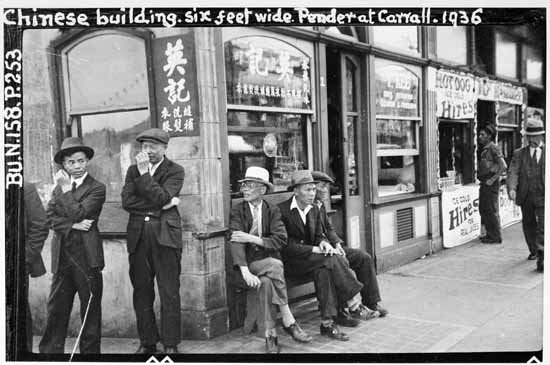
© Public domain / Vancouver Public Library / 17080

Exclusion of Chinese Immigrants (1923-1947)
In 1923, the Canadian government introduced a new Chinese Immigration Act, commonly known as the Chinese Exclusion Act, to stop Chinese immigration. Although immigration from outside of Great Britain and the United States was limited in some way through amendments to the Immigration Act or international agreements, only Chinese persons were excluded from Canada by means of a separate statute that targeted only them. In the 24 years it was in effect, Canada allowed as few as 12 Chinese persons to as many as 50. The exact number is unknown.
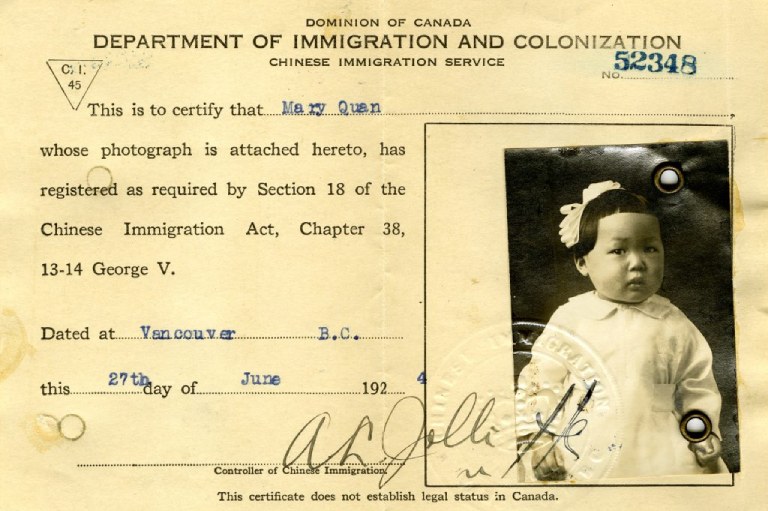
© Courtesy of The Paper Trail collection, University of British Columbia Library Rare Books and Special Collections
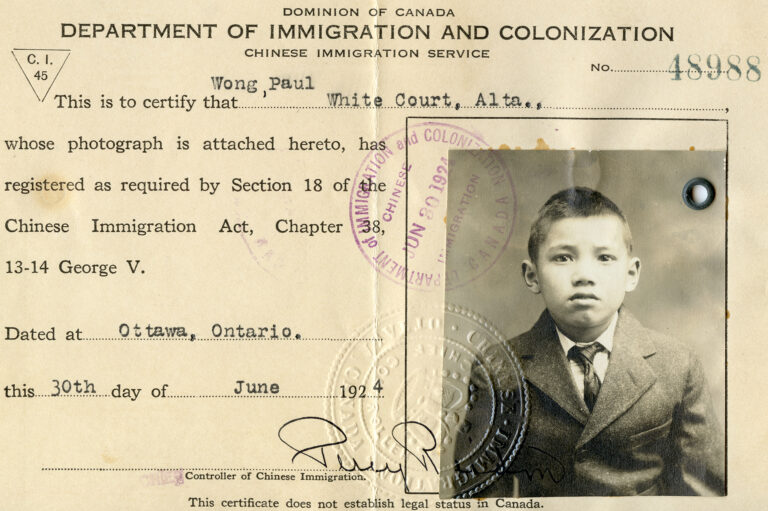
© Courtesy of The Paper Trail collection
The Chinese Exclusion Act was the culmination of widespread anti-Chinese racism and policies increasing in Canada since the 19th century. It replaced the first Chinese Immigration Act of 1885, which included the various head taxes (entry taxes), among other measures to deter immigration from China. Still, Chinese immigration continued, and many white Canadians, predominantly of Anglo-Saxon descent, demanded a complete stop to Chinese immigration. Originating in British Columbia, this movement for exclusion quickly received broad support throughout the country. The new Chinese Immigration Act became law on 1 July 1923, the anniversary of Confederation. From then on, 1 July was “Humiliation Day,” not Dominion Day (Canada Day) for many Chinese Canadians.

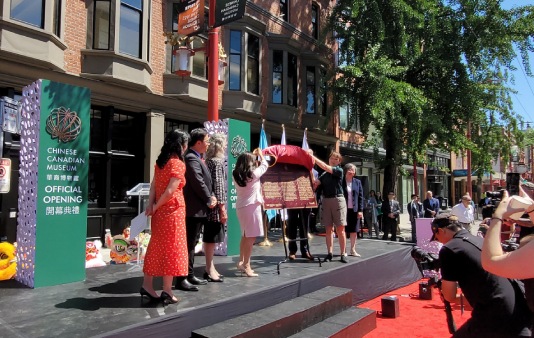
The Chinese Exclusion Act imposed greater restrictions than its predecessor. For example, only Chinese diplomats, government representatives, merchants, Christian missionaries, teachers, Chinese students, children born in Canada who had left for educational or other purposes, and returning Chinese immigrants could be eligible to enter Canada. In addition, the Act prohibited immigrant spouses and children from joining the predominantly male Chinese population in Canada. This virtually halted the growth of Chinese Canadian communities.
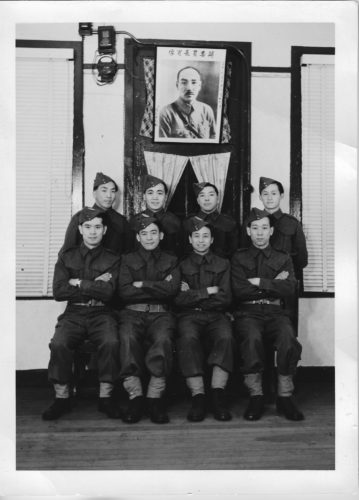
© Courtesy of the Chinese Canadian Military Museum
Significantly, this Act required all Chinese persons living in Canada, even those born here, to register with the government and to carry certificates with photo identification, or risk fines, detainment, or deportation. This was the only time the federal government imposed such a requirement on a non-Indigenous community during peace (the War Measures Act targeted various groups during the First and Second World Wars). Ultimately, Chinese persons continued to face barriers to civil rights and economic opportunities.
During this time, Chinese Canadian leaders and members of organizations such as the Chinese Consolidated Benevolent Association (CCBA) in Canada tried to prevent the passage of the Act and lobbied for less restrictive immigration policies. When the Chinese Exclusion Act was passed, Chinese Canadian men and women began lobbying for its repeal. After the Second World War, veterans and members of the Committee for the Repeal of the Chinese Immigration Act, co-founded by Kew Dock Yip, joined the movement and led successful campaigns. The Act was repealed on 14 May 1947.
Chinese immigration was placed under the jurisdiction of the Immigration Act in the category of Asian immigration, more broadly. Asian immigration was limited to spouses and unmarried children aged 18 or younger of men already living in Canada. In 1955, the age restriction for dependants was increased to 25. In 1967, overt racial restrictions were removed, and the Immigration Act has continued to evolve. After two decades of lobbying, in 2006, Chinese Canadians received an official apology from the federal government for the head taxes and the exclusion of Chinese immigrants.
“This designation means for us that there is now an official memorialization of the grave historical injustice of the Chinese Exclusion Act acknowledging its xenophobia, human rights violation, racial discrimination, and systemic racism. It hampered the development and engagement of the Chinese community and had an adverse impact on generations of Chinese families. Our hope is that this memorialization will serve as a call for all Canadians, and key institutions in Canada, to strengthen educational efforts which recognize the long-term impacts of this exclusionary legislation, and to be aware and to combat contemporary anti-Asian and anti-Chinese racism in Canada, while never forgetting the past.”
This press backgrounder was prepared at the time of the Ministerial announcement in 2023.
Historic designations: In their own words | Exclusion of Chinese Immigrants (1923-1947)
Watch these unique video testimonials from members of the Chinese Canadian community, as they describe this difficult period of time. Hear their perspectives on the importance of connecting with the past and commemorating history in Canada.
The National Program of Historical Commemoration relies on the participation of Canadians in the identification of places, events and persons of national historic significance. Any member of the public can nominate a topic for consideration by the Historic Sites and Monuments Board of Canada.
Related links
- National historic designations
- National historic persons
- National historic sites designations
- National historic events
- Submit a nomination
- Wong Foon Sien National Historic Person (1899-1971)
- The Canadian Encyclopedia: Chinese Immigration Act
- The Paper Trail to the 1923 Chinese Exclusion Act
- This Week in History
- Date modified :